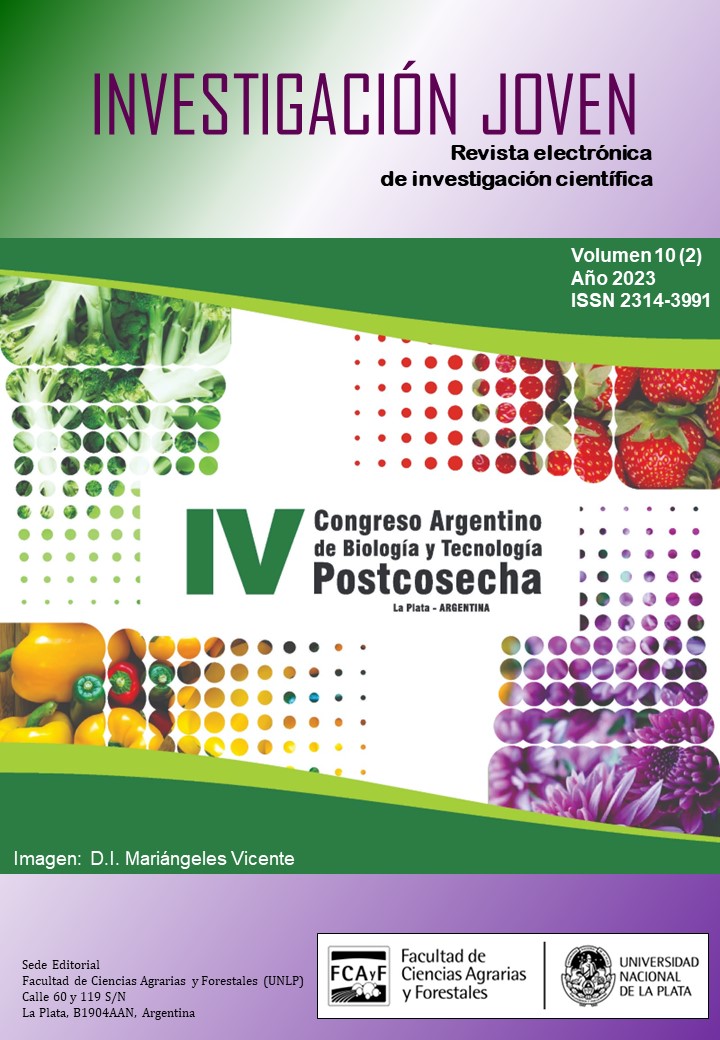Control de podredumbres poscosecha causadas por Penicillium y Botrytis mediante la aplicación de recubrimientos comestibles y sustancias GRAS
Palabras clave:
Penicillium digitatum, Botritys cinérea, limones, tomates, sorbato de potasioResumen
En el Noroeste Argentino, la producción de frutas y hortalizas enfrenta pérdidas económicas por pudriciones fúngicas de pre y poscosecha. Para combatirlas se aplican fungicidas químicos, lo que lleva a la aparición de cepas resistentes y contaminación ambiental. En la búsqueda de alternativas sustentables, en este trabajo se evaluó la formulación de recubrimientos comestibles de almidón de mandioca (Alm) y glicerol con sustancias de baja toxicidad: sorbato de potasio (SK) y polihexametilenguanidina (PHMG) para el control de aislados locales de fitopatógenos. Se ensayaron diferentes concentraciones y la formulación elegida fue 5% de Alm y 1,6% de glicerol, la cual se suplementó con 3 o 6% de SK; 500 o 1000ppm de PHMG o 10ppm de graduate A+®. Los films conteniendo 3% de SK y 500ppm de PHMG fueron capaces de inhibir el crecimiento in vitro de Penicillium digitatum, P. italicum, Botrytis cinérea y P. expansum. En ensayos in vivo se aplicaron dichos recubrimientos en limones inoculados con P. digitatum y en tomates inoculados con B. cinérea, obteniendo una reducción significativa de ambas podredumbres con recubrimientos que contenían 6% de SK. Estos resultados muestran el potencial uso de recubrimientos formulados con compuestos naturales para el control de podredumbres fúngicas de poscosecha.
Descargas
Citas
L. Palou, M.B. Pérez-Gago. “GRAS salts as Alternative Low-Toxicity chemicals for postharvest preservation of fresh horticultural products”. En Plant Pathology in the 21st Century, D. Spadaro, S. Droby, M.L. Gullino, Vol 11. Springer, Cham 2020, 163-179. doi:10.1007/978-3-030-56530-5_11
K. Ncama, "Plant-based edible coatings for managing postharvest quality of fresh horticultural produce: a review." Food Packaging and Shelf Life. 2018 ;16:157-167. doi:10.1016/j.fpsl.2018.03.011
E. Díaz-Montes, R. Castro-Muñoz. "Edible Films and Coatings as Food-Quality Preservers: An Overview". Foods. 2021 ;10(2):249. doi:10.3390/foods10020249
B. Di Millo, V. Martínez-Blay, M.B. Pérez-Gago, et al. "Antifungal hydroxypropyl methylcellulose (HPMC)-Lipid Composite Edible Coatings and Modified Atmosphere Packaging (MAP) to reduce postharvest decay and improve storability of ‘Mollar de Elche’ pomegranates". Coatings. 2021 ;11(3):308. doi:10.3390/coatings11030308
M.E.D. Álvarez, L. Palou, V. Taberner, et al. "Natural Pectin-Based edible composite coatings with antifungal properties to control green mold and reduce losses of ‘Valencia’ oranges". Foods. 2022 ;11(8):1083. doi:10.3390/foods11081083
G.F. Mehyar, H.M. Al-Qadiri, B.G. Swanson. "Edible coatings and retention of potassium sorbate on apples, tomatoes and cucumbers to improve antifungal activity during refrigerated storage". Journal of Food Processing and Preservation. 2012 ;38(1):175-182. doi:10.1111/j.1745-4549.2012.00762.x
L. Cerioni, V.A. Rapisarda, M. Hilal, F.E. Prado, L. Rodríguez-Montelongo. "Synergistic antifungal activity of sodium hypochlorite, hydrogen peroxide and cupric sulfate against Penicillium digitatum". J. Food Prot. 2009 72:1660-5.
L. Cerioni, M.A. Lazarte, J.M. Villegas, L. Rodríguez-Montelongo, S.I. Volentini. "Inhibition of Penicillium expansum by an oxidative treatment". 2013 Food Microbiol. 33: 298-301.
L. Cerioni, V.A. Rapisarda, J. Doctor, S. Fikkert, T. Ruiz, R. Fassel, J.L. Smilanick. "Use of phosphite salts in laboratory and semi-commercial tests to control citrus postharvest decay". 2013. Plant Disease 97: 201-212.
G.M. Olmedo, L. Cerioni, M. Sepúlveda, J.C. Ramallo, V.A. Rapisarda, S.I. Volentini. "Polyhexamethylene guanidine as a fungicide, disinfectant and wound protector in lemons challenged with Penicillium digitatum". Food Microbiology. 2018 ;76:128-134. doi:10.1016/j.fm.2018.03.018
J.I. Pitt, A.D. Hocking. “Methods for isolation, enumeration and identification”. En Fungi and Food Spoilage, Springer, Boston: MA. 2009:19-52. doi:10.1007/978-0-387-92207-2_4
G.A. Gianinetto Gola,“Manejo de poscosecha en limón: monitoreo ambiental y revalorización de conceptos claves para el control de moho verde causados por Penicillium digitatum.” Tesina de Grado, Facultad de Bioquímica, Química y Farmacia, Universidad Nacional de Tucumán, Tucumán 2015.
V. Jesús Lazarte, “Evaluación de tratamientos alternativos, sales de baja toxicidad y nuevas moléculas para el control de cepas de Penicillium digitatum e italicum resistentes a Imazalil, Tiabendazol y Pirimetanil” Tesina de Grado, Facultad de Bioquímica, Química y Farmacia, Universidad Nacional de Tucumán, Tucumán 2018.
J.L. Smilanick, M. Mansour, F.M. Gabler, D. Sorenson, "Control of citrus postharvest green mold and sour rot by potassium sorbate combined with heat and fungicides." Postharvest Biology and Technology. 2008;47(2):226-238. doi:10.1016/j.postharvbio.2007.06.020
G.F. Mehyar, H.M. Al-Qadiri, H.A. Abu-Blan, B.G. Swanson. "Antifungal effectiveness of potassium sorbate incorporated in edible coatings against spoilage molds of apples, cucumbers, and tomatoes during refrigerated storage". Journal of Food Science. 2011;76(3):M210-M217. doi:10.1111/j.1750-3841.2011.02059.x
Y. Yang, H. Chen, X. Liang, S. Fang, J. Wang, J. Chen. "Development of Starch-Based antifungal coatings by incorporation of Natamycin/Methyl-Β-Cyclodextrin inclusion complex for postharvest treatments on cherry tomato against Botrytis cinerea". Molecules. 2019;24(21):3962. doi:10.3390/molecules24213962
O.V. López, L. Giannuzzi, N.E. Zaritzky, M.A. García, “Potassium Sorbate controlled release from Corn Starch Films.”, Materials Science and Engineering: C. 2013 ;33(3):1583-1591. doi:10.1016/j.msec.2012.12.064
Boletin Oficial República Argentina - Secretaría de Regulación y Gestión Sanitaria y Secretaría de Alimentos y Bioeconomía - Resolución Conjunta 5/2019.
Boletín oficial República Argentina – Secretaría de Políticas, Regulación e Institutos A.N.M.A.T – Disposición N° 7668 – 12 de Julio 2017.
Descargas
Publicado
Cómo citar
Número
Sección
Licencia
Derechos de autor 2023 Benjamín José Bertini, Mario Alberto Debes, Viviana Andrea Rapisarda, Luciana Cerioni, Sabrina Inés Volentini

Esta obra está bajo una licencia internacional Creative Commons Atribución-NoComercial-CompartirIgual 4.0.
















